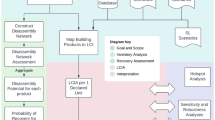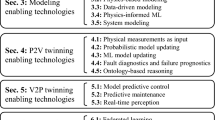Abstract
Background, aim, and scope
The term “information module” has been initially introduced by ISO 14025 (ISO 14025 2006) which specifies Type III environmental declarations. It comprises a set of predetermined parameters (PDPs) assigned to a process. Such a process can be part of a product system, i.e., a unit process or a combination of unit processes as, e.g., the production processes of a company. Independent information modules (IIMs) of processes within a system are modeled in a way that the predetermined parameters of the information modules related to these processes are identical and sufficiently independent so they can be added up to the predetermined parameters of such a system, typically after multiplication with specific factors based on the reference flow of the system.
Materials and methods
This paper shows how IIMs can be used as powerful approach in life cycle management and how operations, goods, and services of a company can be modeled efficiently with the help of IIMs. To define environmental objectives of their operations, organizations typically assess their foreground processes but do not apply system expansion for each of the foreground processes to include background processes. With the help of IIMs, background processes can be easily included, and the PDPs, therefore, also include both direct and indirect elementary flows, i.e., emissions and resources. In a “plant ecobalance” the PDPs of the different (foreground and background) processes of an organization can be determined and added up. This provides each process owner with important information about the environmental aspects which he or she can control and shows options for setting and implementing environmental objectives. For specific purposes, the number of PDPs can be restricted or even limited to one parameter, e.g., the carbon footprint. This paper illustrates the method with one example of the aluminum industry (carbon footprint of an automotive bumper beam) and shows how PDPs of product systems can be built up from IIMs which represent the different stages of a life cycle; how such results can show the influence of these stages in a transparent way, as required as a part of the life cycle interpretation phase.
Results and discussion
Life cycle assessments (LCAs) based on IIMs follow the principles and requirements of ISO 14040 (2006) and ISO 14044 (2006), as applicable. However, as a specific approach of life cycle management, they can obtain the required information with less effort than “conventional” LCAs where, following the guidance of ISO 14044, indicator results are calculated after the inventory data have been aggregated for the whole product system. Future efforts in ISO standardization should strengthen the role of LCA as a tool of environmental management.





Similar content being viewed by others
References
Fleischer G, Hake J-F (2002) Aufwands- und ergebnisrelevante Probleme der Sachbilanzierung. Schriften des Forschungszentrums Jülich, Reihe Umwelt, Band 30. Jülich, Germany, Forschungszentrum Jülich
Guinée JB, Gorrée M, Heijungs R, Huppes G, Kleijn R, de Koning A, van Oers L, Sleeswijk AW, Suh S, Udo de Haes HA (2002) Handbook on life cycle assessment—operational guide to the ISO standard. Kluwer Academic, Dordrecht
Helms H, Lambrecht U (2007) The potential contribution of light-weighting to reduce transport energy consumption. Int J Life Cycle Assess 12(2):58–64
International Standard ISO 14001 (2006) Environmental management. International Organization for Standardization, Geneva
International Standard ISO—Technical Report ISO/TR 14047 (2003) Environmental management—life cycle impact assessment—examples of application of ISO 14042. International Organization for Standardization, Geneva
International Standard ISO 14025 (2006) Environmental labels and declarations—type III environmental declarations. International Organization for Standardization, Geneva
International Standard ISO 14040 (2006) Environmental management—life cycle assessment—principles and framework. International Organization for Standardization, Geneva
International Standard ISO 14044 (2006) Environmental management—life cycle assessment—requirements and guidelines. International Organization for Standardization, Geneva
International Standard ISO 21930 (2007) Sustainability in building construction—environmental declaration of building products. International Organization for Standardization, Geneva
Rebitzer G (2005) Enhancing the application efficiency of life cycle assessment for industrial uses. PhD Thesis, Swiss Federal Institute of Technology, Lausanne (EPFL)
Udo de Haes HA, Jensen AA, Klöpffer W, Lindfors LG (1994) Integrating impact assessment into LCA. Society of Environmental Toxicology and Chemistry (SETAC), Brussels
Weidema B, Ekvall T, Pesonen H-L, Rebitzer G, Sonnemann G, Spielmann M, Rebitzer G, Ekvall T (2004) Scenarios in life-cycle assessment. Society of Environmental Toxicology and Chemistry (SETAC), Pensacola
Author information
Authors and Affiliations
Corresponding author
Additional information
Responsible editor: Gerald Rebitzer and Jörg Schäfer.
Special Issue “Life Cycle Performance of Aluminium Applications”
Rights and permissions
About this article
Cite this article
Buxmann, K., Kistler, P. & Rebitzer, G. Independent information modules—a powerful approach for life cycle management. Int J Life Cycle Assess 14 (Suppl 1), 92–100 (2009). https://doi.org/10.1007/s11367-009-0075-7
Received:
Accepted:
Published:
Issue Date:
DOI: https://doi.org/10.1007/s11367-009-0075-7




